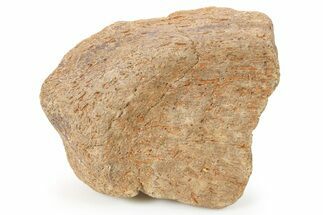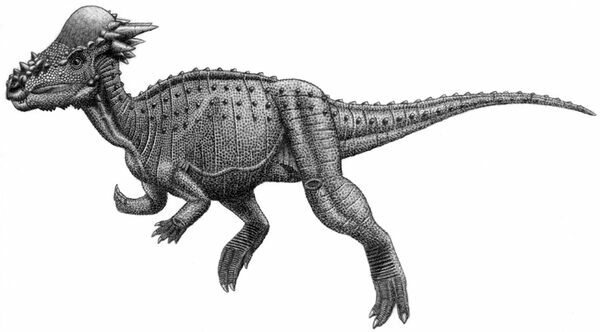This Specimen has been sold.
2" Fossil Pachycephalosaur Vertebra - Wyoming
This is a 2" wide fossil Pachycephalosaur vertebra centrum from the Lance Formation of Wyoming.
Pachycephalosaurs are a family of bipedal dinosaurs that lived during the Late Cretaceous and had a distinctive, large, bony dome on top of their skull. This dome was sometimes up to 10 inches thick and was thought to cushion their brain from impacts. Some paleontologists believe this thick skull may have been used for head-butting, much like modern rams, while others contend it may have been a sexual display. They were either an herbivore or omnivore with small leaf-shaped teeth effective for shredding plants.
There are more than a dozen described genera of Pachycephalosaurs, though Pachycephalosaurus from the Hell Creek Formation is the best known.
There are more than a dozen described genera of Pachycephalosaurs, though Pachycephalosaurus from the Hell Creek Formation is the best known.
About The Lance Formation
The Lance Formation of Wyoming, which dates back to the Late Cretaceous period between 66 and 69 million years ago, is home to a wide variety of both dinosaur and assorted small vertebrate fossils. During the Cretaceous, this midwestern formation would have been comprised of streams connected to the large Western Interior Seaway that split continental North America in half down the midwest. As a result of the subtropical climate and frequent rainfall, life flourished both on land and in the sea. These wet environments created perfect scenarios for sediment deposition, making the resulting Lance Formation such a fertile fossil site.
Perhaps the most famous Lance resident would be Tyrannosaurus rex, the largest North American carnivore to ever live. However, other smaller theropods also roamed the American midwest in this subtropical coastal stream system, including the beaked Ornithomimus, a lanky running theropod with a build similar to a modern ostrich, as well as several small predatory troodonts such as Paronychodon and Pectinodon.
Herbivorous dinosaurs also took advantage of the abundance offered by this unique era. Armored ankylosaurs dwelt in herds, their safety assured by their numbers, their heavy bone plating protecting most of their bodies and even their eyelids, and huge bone clubs on the ends of their tails providing them with powerful offensive capabilities. Ceratopsians like the famous Triceratops also formed protective herds, guarding their necks with frills and horns. Their smaller relatives, the dome-headed pachycephalosaurs, were also well represented in the area. Hadrosaurs, duck-billed titans with huge batteries of plant-grinding teeth in elongated snouts, are also well known from the region.
In addition to dinosaurs, a wide variety of fishes, amphibians, lizards, snakes, turtles, champsosaurs, crocodilians, and pterosaurs have been found in the formation.
The Lance Formation of Wyoming, which dates back to the Late Cretaceous period between 66 and 69 million years ago, is home to a wide variety of both dinosaur and assorted small vertebrate fossils. During the Cretaceous, this midwestern formation would have been comprised of streams connected to the large Western Interior Seaway that split continental North America in half down the midwest. As a result of the subtropical climate and frequent rainfall, life flourished both on land and in the sea. These wet environments created perfect scenarios for sediment deposition, making the resulting Lance Formation such a fertile fossil site.
Perhaps the most famous Lance resident would be Tyrannosaurus rex, the largest North American carnivore to ever live. However, other smaller theropods also roamed the American midwest in this subtropical coastal stream system, including the beaked Ornithomimus, a lanky running theropod with a build similar to a modern ostrich, as well as several small predatory troodonts such as Paronychodon and Pectinodon.
Herbivorous dinosaurs also took advantage of the abundance offered by this unique era. Armored ankylosaurs dwelt in herds, their safety assured by their numbers, their heavy bone plating protecting most of their bodies and even their eyelids, and huge bone clubs on the ends of their tails providing them with powerful offensive capabilities. Ceratopsians like the famous Triceratops also formed protective herds, guarding their necks with frills and horns. Their smaller relatives, the dome-headed pachycephalosaurs, were also well represented in the area. Hadrosaurs, duck-billed titans with huge batteries of plant-grinding teeth in elongated snouts, are also well known from the region.
In addition to dinosaurs, a wide variety of fishes, amphibians, lizards, snakes, turtles, champsosaurs, crocodilians, and pterosaurs have been found in the formation.
SPECIES
Pachycephalosaur
LOCATION
Wyoming
FORMATION
Lance Formation
SIZE
2" wide
CATEGORY
SUB CATEGORY
ITEM
#288082
We guarantee the authenticity of all of our specimens.
 Reviews
Reviews














